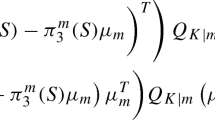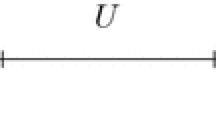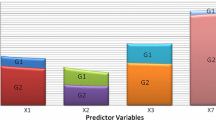Abstract
In classification, with an increasing number of variables, the required number of observations grows drastically. In this paper we present an approach to put into effect the maximal possible variable selection, by splitting a K class classification problem into pairwise problems. The principle makes use of the possibility that a variable that discriminates two classes will not necessarily do so for all such class pairs.
We further present the construction of a classification rule based on the pairwise solutions by the Pairwise Coupling algorithm according to Hastie and Tibshirani (1998). The suggested proceedure can be applied to any classification method. Finally, situations with lack of data in multidimensional spaces are investigated on different simulated data sets to illustrate the problem and the possible gain. The principle is compared to the classical approach of linear and quadratic discriminant analysis.
Access this chapter
Tax calculation will be finalised at checkout
Purchases are for personal use only
Preview
Unable to display preview. Download preview PDF.
Similar content being viewed by others
References
BISHOP, Y., FIENBERG, S. and HOLLAND, P. (1975): Discrete multivariate analysis, MIT Press, Cambridge.
BRADLEY, R. and TERRY, M. (1952): The rank analysis of incomplete block designs, i. the method of paired comparisons, Bimometrics, 324–345.
BREIMAN, L. FRIEDMAN, J., OLSHEN, R. and STONE, C. (1984): Classification and regression trees. Chapman & Hall, NY.
HAJEK, J. (1969): A course in nonparametric statistics. Holden Day, San Francisco.
HASTIE, T. and TIBSHIRANI, R. (1998): Classification by Pairwise Coupling. Annals of Statistics, 26(1), 451–471.
SCOTT, D. (1992): Multivariate Density Estimation Wiley, NY.
Author information
Authors and Affiliations
Editor information
Editors and Affiliations
Rights and permissions
Copyright information
© 2006 Springer Berlin · Heidelberg
About this paper
Cite this paper
Szepannek, G., Weihs, C. (2006). Variable Selection for Discrimination of More Than Two Classes Where Data are Sparse. In: Spiliopoulou, M., Kruse, R., Borgelt, C., Nürnberger, A., Gaul, W. (eds) From Data and Information Analysis to Knowledge Engineering. Studies in Classification, Data Analysis, and Knowledge Organization. Springer, Berlin, Heidelberg. https://doi.org/10.1007/3-540-31314-1_86
Download citation
DOI: https://doi.org/10.1007/3-540-31314-1_86
Publisher Name: Springer, Berlin, Heidelberg
Print ISBN: 978-3-540-31313-7
Online ISBN: 978-3-540-31314-4
eBook Packages: Mathematics and StatisticsMathematics and Statistics (R0)




